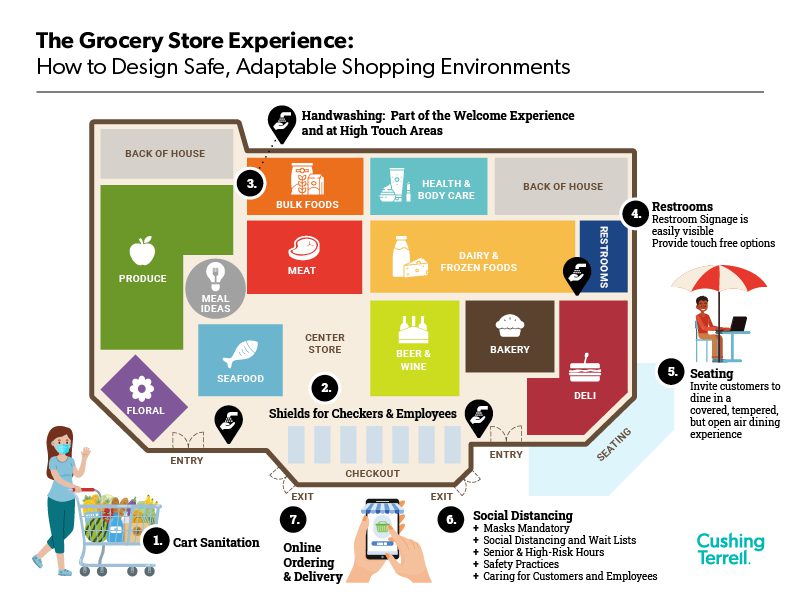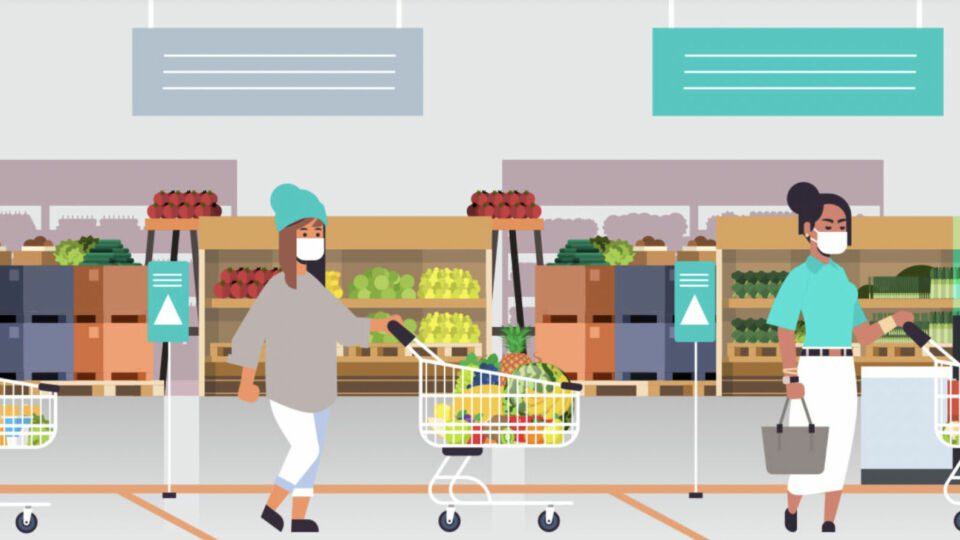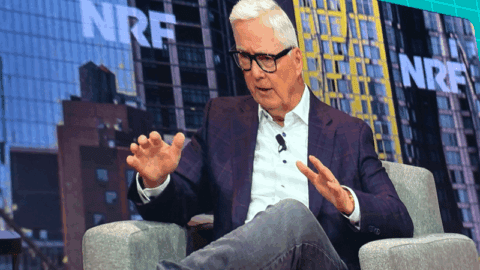As we continue to settle into the economic and psychological realities of COVID-19, businesses are evaluating what response tactics worked well in 2020 and where there’s room for improvement to ensure resilience going forward. For businesses deemed essential, such as grocery stores, the learning curve has been short and steep — adapting hasn’t been about “if,” but “how” and “how fast.”
There are some shining examples of stores that have, under the circumstances, truly embraced the process of evaluating and improving the in-store experience, both on-the-fly and for the long term. When the pandemic took hold, Seattle-area Town & Country Markets (T&C) went to work ensuring their customers still felt safe and well-cared-for. As 2020 came to a close, the company wanted to confirm that the changes made (and those being planned) set them up for success in 2021 and beyond. In partnership with Cushing Terrell, T&C dug deeper into the progress made and what’s still needed down the road.
The Research
To gather insights as part of the Post Occupancy Evaluation process, T&C and the Building Performance team at Cushing Terrell developed and distributed a survey to T&C’s customer base across their six store locations. More than 800 customers completed the survey, which was designed to gauge confidence and overall satisfaction in the grocery shopping experience thus far during the pandemic — 97% of those surveyed had visited one of T&C’s stores within the previous month.
The survey spanned a combination of qualitative and quantitative metrics, providing valuable information about the revised customer experience.
What We Learned
Many of those surveyed reported perceiving T&C as having a superior response compared to other stores in the region. Descriptions included “miles above” any other store, the “gold standard in grocery shopping,” and “the best place to shop because of hygiene measures in place.” Many noted that their positive perception of T&C’s COVID-19 response has increased their loyalty. Some of the adaptive measures were unique to T&C’s brand, while others can be applied to grocery store experiences more universally to instill confidence and enhance health and safety precautions in any store.
- Sanitization was made central to in-store operations with supplies made readily available to customers for their own use. 96% of customers said they were satisfied with the availability of sanitizing material wipes, sanitizer dispensers and hand-washing facilities; and 70% of shoppers reported they would use a hand-washing station if it was made available.
- In-store signage and reminders of the new procedures were prevalent and visible throughout the store. One-way aisles were implemented, 6-foot distancing decals were applied to the floor near check stands, and senior-only shopping hours were established. Fewer than 10% of customers surveyed reported feeling inconvenienced or like their shopping experience was made more difficult.
- Curbside pickup was accelerated and launched within eight weeks after the pandemic began. It had been planned for years, but COVID-19 created significant urgency. T&C plans to enhance online ordering in their new stores and make it a highlighted part of the shopping experience.
- Communication was increased across all channels. Customers reported a heavy reliance on social media, T&C’s website, and in-store messaging for updates and other information: 63% and 55% of respondents referred to T&C social media and website, respectively, before visiting a store.
Planning for Improvement
While T&C’s responses were widely considered positive and productive, there are still many opportunities for improvement. Several of these, as noted by the customers surveyed, centered on the increased use of technology, in-store environmental factors and some platform-building service add-ons. The top six most-referenced common sentiments were:
- Communication, communication, communication. A store traffic indicator was suggested as a resource; as was the use of digital signage to help locate specials, give information about current pricing and inventory; and to replace the meal inspiration centers, which were a T&C signature feature pre-pandemic sharing photos, suggestions and inspiration. One-way aisles elicited the most commentary. Suggestions included bolder aisle markers, aisle markers at eye level in addition to floor level, and eliminating confusing combinations of one-way and two-way aisles (e.g., make them all one-way or all two-way).
- Increased precautionary measures outside of the store. These might include temperature checks and health screenings prior to entering the store.
- Suggestions for the store itself. Items included improving indoor air quality (since the survey was issued, T&C has upgraded their in-store HVAC filtration with a Merv13 filter, previously a Merv8), or giving visibility to the air quality for easy assessment). Additional suggestions included remedying bottlenecks that occur at check stands due to measures taken to ensure social distancing, and increasing access and availability to outdoor spaces for gathering, dining and purchasing.
- Other customer suggestions included a virtual personal shopper service via video chat and converting self-service stations (such as salad bars) into pre-packed or employee-packed prepared food stations. Customers were split 50/50 on whether they would use the traditional self-serve stations even after the pandemic has passed.
- Customers commented that online ordering could use more visibility and improved ease of use. T&C customers expressed interest in a service such as curbside pickup, but felt they needed more information: 85% of customers surveyed said they had not used the online ordering system, alluding to a lack of awareness about the service.
- Leaning on/into technology will help advance not only previously mentioned digital communication options, but also other in-store safety measures such as automated cart sanitizing systems, touchless checkout and a mobile app designed to limit time spent in the store. Features like these were requested in several open response fields within the survey.

Looking Ahead
It should come as no surprise that a recurring theme throughout the survey was the need for enhanced communication. Be it leveraging social media and website content for updates and information, improving tools such as digital wait-list systems or providing opportunities to share feedback, customers want to feel they have access to information on any front, at any time. Creating bolder, more consistent signage in stores with supplemental audio announcements could also help with wayfinding and the ability to locate hand-washing stations throughout the store.
People look forward to their outing to the “essential” grocery store if they feel confident and safe while there. They’re looking to stores to provide guidance and help them safely navigate their shopping experience.
Advancing Retail and Grocery Design
Communication won’t solve for every variable, however, and additional store design considerations will need to be made, including incorporating new technologies that aid in sanitation and checkout convenience. Store design may need to make subtle shifts to widen aisles, provide more space in checkout areas, and locate restrooms (with automated doors, toilets, faucets, soap dispensers and paper towel dispensers) and hand-washing stations at the front of stores, as well as address safe space for employees to be when on their breaks.
Pre-pandemic, small store formats were on the rise as consumers favored local, more tailored products. Leveraging this movement, we may start to see stores explore a combination of this concept with the increased need for fulfillment space to accommodate online and curbside ordering. Shopping environments may be smaller in some cases, backed by technological enhancements and designed to feel fresh and engaging, but ultimately served by a warehouse-like backroom.
As we continue to survey, test and research, there will be increasing clarity around what grocery customers want to feel and touch in a store, and what they’d rather not have to interact with while still benefitting from the food and flavor curation that only a local grocery market can provide.

Based in Seattle, Kara Eberle is an associate principal, architect and project manager at Cushing Terrell. She has been with the firm for nearly 10 years, during which time she has helped drive progress through her Equity by Design leadership and exceptional client care, serving as designer and trusted advisor from the initial design phase through project completion and beyond. She specializes in the retail and commercial markets with a particular focus on gourmet grocery stores and workplaces for high-tech clients.








